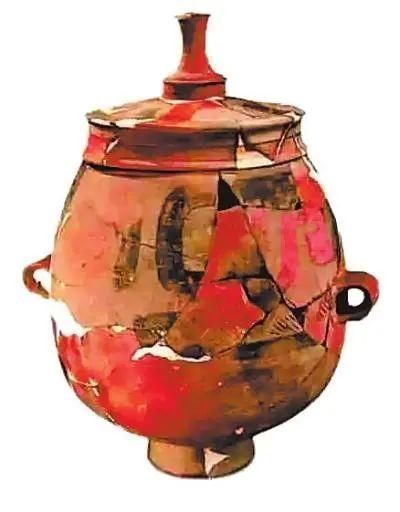城址$双语说河南|在中原 追寻夏的轨迹( 七 )
小城始建年代为新砦期早段(夏代早期),二里头一期(夏代中期)时完全废弃。东赵遗址的这座城址是嵩山以北区域第一座新砦期城址。中城城址始建于二里头二期,废弃于二里头四期(夏代晚期)。目前所见二里头文化城址不多,东赵二里头文化城址,对于夏的区域聚落形态及政治地理结构研究,是不可回避的重点对象。
The Dongzhao Site might be an important military base. The sites of Dashigu, Wangjinglou and Dongzhao are all located to the east of the Erlitou Site, forming a fan shape, aiming to protect the royal families of the Xia Dynasty from the invaders of the later Shang Dynasty.
东赵遗址可能是重要的军事据点。与大师姑、望京楼的夏代城址都在二里头都邑的东方,呈扇形拱卫态势,是夏王室为了防范来自东方的商和东夷族群进行的特殊防卫措施。
Major discoveries include the remains of three ancient cities in different periods which are stacked on top of one another, bone pits, sacrificial pits, distinctive flat-mouth pot, etc.
重要遗迹遗物:大中小“三套城”、卜骨坑、祭祀坑、极具特色的扁嘴壶等。

文章插图
The Huadizui Site in Gongyi: 'The Songs of the Five Sons' Composed in Luorui
巩义花地嘴遗址:《五子之歌》起洛汭
Located in Luorui area (where the Luohe River flows into the Yellow River) in Gongyi city of Henan province, the Huadizui Site was first discovered in 1984 and called the Shuigou Site at that time. As one of the projects aimed at tracing the origins of Chinese civilization, it was listed as one of the seventh batch of national key cultural relics by the State Council in May 2013.
位于巩义洛汭地区的花地嘴遗址是1984年发现的,当时定名为“水沟遗址”。2013年5月,被国务院核定公布为第七批全国重点文物保护单位,近年被列为“中华文明探源工程”研究项目之一。
From 2001 to 2007, Zhengzhou Institute of Cultural Relics and Archaeology had launched several investigations and excavations at the Huadizui Site and discovered many important cultural relics, including ring trenches, sacrificial pits, house ruins, ash pits and pottery-kiln remains. Besides, implements made of stones, bones and clamshells were also unearthed along with pottery wares, jade products, pottery wares painted with cinnabar, many animal bones and grains. The four ring trenches (with southeast gates) and sacrificial pits are of great significance. With rounded corners and square shape, the three inner trenches are quite close to each other, but have different width. There seems to be a northwest-southeast road linking the people within the 4 trenches with other places, since gaps have been found in the southeast part of all the trenches. These gaps should be the trenches' southeast gates. Near the outer gate discovered multiple sacrificial pits which are irregular and nearly round in shape due to repeated usage, with a number of human bones, animal skeletons and various burial implements found.
2001年至2007年,郑州市文物考古研究院联合相关单位先后对花地嘴遗址进行多次调查与发掘,共发现重要遗迹有:环壕、祭祀坑、房址、灰坑及陶窑。出土有骨、石、蚌器、陶器、玉器、朱砂绘陶礼器、诸多动物骨骼及农作物颗粒。花地嘴的环壕和祭祀坑非常重要,共发现四条环壕和环壕东南大门,四条环壕中的内三条相距颇近,四条环壕与外界的连接通道均在东南部位,并且都在一条西北-东南方向的直线上,这里的缺口应该是东南大门。大门附近有多个祭祀坑,系多次祭祀形成,发现其中有数具人骨、动物牺牲骨骼和各类器物。
The Huadizui Site can best represent the Xinzhai Phase remains. The less than 100-year-long history from Taikang's lose of power and Shaokang's restoration of Xia's governance is just in line with the usage duration of the Huadizui Site. The Huadizui Site of the early Xia Dynasty is believed to be the place where the 5 younger brothers of Taikang, the third king of the Xia Dynasty, composed the reputational poem Songs of the Five Sons after Taikang lost power and was driven out of the city by tribal leader Yi (around 1998 BC-1940 BC).
- 小说$6本男主假高冷小说,强推《镇河》好好笑,作者脑洞未免也太大了
- 王之心&四本开局就惊艳读者的小说,一看书名就想入坑,书荒的你值得拥有
- 船夫&新科状元乘船回家,船夫随口说出一上联,状元却至死都没对出来
- 热血小说$15年老书虫推荐3本百看不厌的热血小说,值得你通宵达旦看完啊!
- 梁炎东!3部强逻辑悬疑小说,人间修罗案神乎其神,谁能戳破鬼怪谣言?
- |茅奖小说《暗算》出版20年,精装版归来继续密码和人心全解密
- 逍遥小书生!五本不输《赘婿》的架空历史小说,评分高达9.5!全部都是精品
- 方腊#鲁智深生擒方腊后说了2句话,共6个好汉听懂了,离开宋江得善终
- 进化&碾压《诡秘之主》,反超《牧神记》,辰东这本小说爆红逆袭登顶
- 帕子@《我的前夫是宦官》当我的丈夫是个宦官,我和他不得不说的故事!
